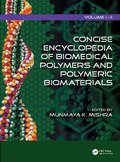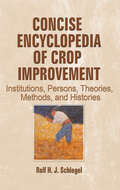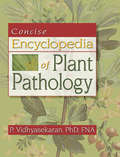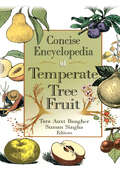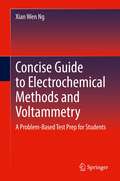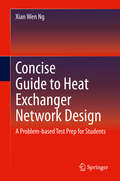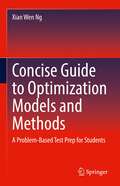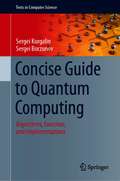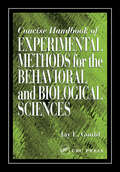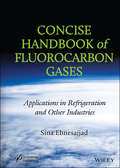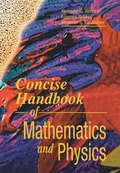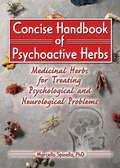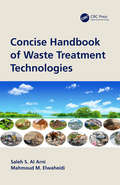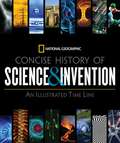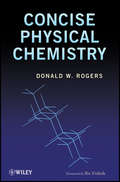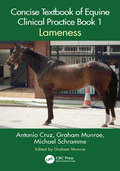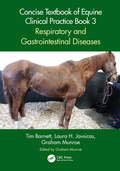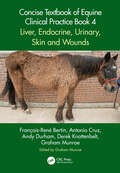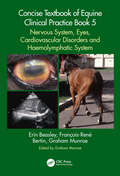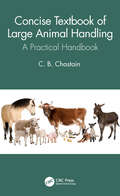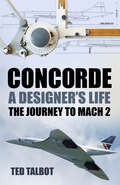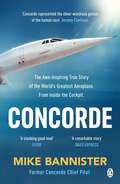- Table View
- List View
Concise Encyclopedia of Biomedical Polymers and Polymeric Biomaterials
by Munmaya MishraThe Concise Encyclopedia of Biomedical Polymers and Polymeric Biomaterials presents new and selected content from the 11-volume Biomedical Polymers and Polymeric Biomaterials Encyclopedia. The carefully culled content includes groundbreaking work from the earlier published work as well as exclusive online material added since its publication in print. A diverse and global team of renowned scientists provide cutting edge information concerning polymers and polymeric biomaterials. Acknowledging the evolving nature of the field, the encyclopedia also features newly added content in areas such as tissue engineering, tissue repair and reconstruction, and biomimetic materials.
Concise Encyclopedia of Crop Improvement: Institutions, Persons, Theories, Methods, and Histories
by Rolf SchlegelHow were today' complex approaches to improving crops developed? The quest for a steady food supply sparked plant breeding attempts over 12,000 years ago. The Concise Encyclopedia of Crop Improvement is a comprehensive resource explaining the development of crop improvement methods over the centuries. This extensive history of development is examined in detail, including influential individuals in the field, plant cultivation in Asia since the Neolithic time, techniques used in the Old World, and cropping in ancient America. The advance of scientific plant breeding in the twentieth century is extensively explored, including hybrid breeding, biotechnological improvement, and genetic manipulation.
Concise Encyclopedia of Plant Pathology
by Perumal VidhyasekaranAn easy-to-use single reference source covering the full range of subject areas associated with plant pathology! This comprehensive volume covers the entire field of plant pathology. It does not merely define the numerous subjects covered (297 topics carefully arranged in 38 sections!) but describes them in detail. Each section of this boo
Concise Encyclopedia of Supersymmetry: And Noncommutative Structures in Mathematics and Physics
by Steven Duplij Warren Siegel Jonathan BaggerThe book is the first full-size Encyclopedia which simultaneously covers such well-established and modern subjects as quantum field theory, supersymmetry, supergravity, M-theory, black holes and quantum gravity, noncommutative geometry, representation theory, categories and quantum groups, and their generalizations. The extraordinary historical part "the SUSY story," more than 700 authored articles from more than 250 high-level experts (including Nobel Prize Winner Gerard 't Hooft), a detailed (50 pages) Subject/Article three level index and an Author index, make the SUSY Encyclopedia an outstanding and indispensable book on the desk of researchers, experts, Ph. D. students, specialists and professionals in modern methods of theoretical and mathematical physics.
Concise Encyclopedia of Temperate Tree Fruit
by Tara Auxt Baugher Suman SinghaFrom Anatomy to Wildlifeeverything you need to know about temperate-zone tree fruit culture and physiology! The Concise Encyclopedia of Temperate Tree Fruit is a unique resource that examines all aspects of tree fruit cultivation in the world's temperate zones. This book addresses more than 40 topics, and included with each topic is a list of resources you can use to find further information. Subjects from molecular genetics to fruit color to pest management are addressed comprehensively and in plain language, so you can get the information you need when you need it. Many helpful illustrations and tables make the data even more accessible. Compiled by some of the most respected names in the field, the Concise Encyclopedia of Temperate Tree Fruit presents the latest research and advances into a wide range of subjects, including fruit maturity, plant hormones, fruit nutritional compositions, and rootstock selection. From the mechanics of plant respiration to the nuances of tree training systems, it’s all inside. Some topics the Concise Encyclopedia of Temperate Tree Fruit examines are: past and future cultivar development innovations in packing equipment the benefits of high-density orchards mechanisms of cold hardiness vital components of site preparation carbohydrate distribution and whole-plant efficiency advances in sustainable production systems If your work or research includes apples, pears, quinces, peaches, apricots, plums, cherries, or any other temperate-zone tree fruit, the Concise Encyclopedia of Temperate Tree Fruit will be your one-stop reference.
Concise Guide to Electrochemical Methods and Voltammetry: A Problem-Based Test Prep for Students
by Xian Wen NgThis book provides targeted support for students taking courses at the undergraduate level involving electrochemical methods and voltammetry, precision analytical techniques used in chemical engineering, chemical research and development, and pharmaceutical science. The learning method applied in this book, and the contents chosen, have been specifically tried-and-tested to support students preparing for exams, and for those having difficulty absorbing concepts and attaining an analytical understanding of their application. Through this book, “written for students by a student,” the author provides accessible learning resources that address students’ needs when preparing for examinations.
Concise Guide to Heat Exchanger Network Design: A Problem-based Test Prep for Students
by Xian Wen NgThis book serves as an extensive practice manual for the understanding and practice of heat exchanger design fundamentals and principles. It also provides a useful resource to upper undergraduate students, who are required to complete final year design projects as part of graduation. The book complements other key topics in science and engineering courses well, such as the branch of thermodynamics which relates closely to the core design principles for heat exchanger networks (FThis book serves as an extensive practice manual for the understanding and practice of heat exchanger design fundamentals and principles. It also provides a useful resource to upper undergraduate students, who are required to complete final year design projects as part of graduation. The book complements other key topics in science and engineering courses well, such as the branch of thermodynamics which relates closely to the core design principles for heat exchanger networks (First and Second Laws of Thermodynamics).Provides balanced content with numerical and open-ended problems;Tailored to the needs of students and teachers; Concise yet rigorous treatment of concepts;Incorporates use of visuals to aid learning;Reinforces engineering concepts in real-life applications.
Concise Guide to Optimization Models and Methods: A Problem-Based Test Prep for Students
by Xian Wen NgThis concise text contains the most commonly-encountered examination problems in the topic of Optimization Models and Methods, an important module in engineering and other disciplines where there exists an increasing need to operate optimally and sustainably under constraints, such as tighter resource availability, environmental consideration, and cost pressures. This book is comprehensive in coverage as it includes a diverse spectrum of problems from numerical open-ended questions that probe creative thinking to the relation of concepts to realistic settings. The book adopts many examples of design scenarios as context for curating sample problems. This will help students relate desktop problem-solving to tackling real-world problems. Succinct yet rigorous, with over a 100 pages of problems and corresponding worked solutions presented in detail, the book is ideal for students of engineering, applied science, and market analysis.
Concise Guide to Quantum Computing: Algorithms, Exercises, and Implementations (Texts in Computer Science)
by Sergei Kurgalin Sergei BorzunovThis textbook is intended for practical, laboratory sessions associated with the course of quantum computing and quantum algorithms, as well as for self-study. It contains basic theoretical concepts and methods for solving basic types of problems and gives an overview of basic qubit operations, entangled states, quantum circuits, implementing functions, quantum Fourier transform, phase estimation, etc. The book serves as a basis for the application of new information technologies in education and corporate technical training: theoretical material and examples of practical problems, as well as exercises with, in most cases, detailed solutions, have relation to information technologies. A large number of detailed examples serve to better develop professional competencies in computer science.
Concise Handbook of Experimental Methods for the Behavioral and Biological Sciences
by Jay E. GouldAlthough there are many books written on the principles and methods of experimentation, few are written in a succinct, comprehensive outline format. The Concise Handbook of Experimental Methods for the Behavioral and Biological Sciences is based on a popular course taught by the author for more than two decades to assist advanced undergraduate and
Concise Handbook of Fluorocarbon Gases: Applications in Refrigeration and Other Industries
by Sina EbnesajjadThis book describes fluorocarbons gases’ preparation process, properties, applications and their evolution over time. The impact of fluorocarbons on the ozone layer and global and the development to mitigate those effects have been specially emphasized. The first major industrial fluorinated compound was developed in the 1920’s, to replace ammonia and sulfur dioxide refrigerants, at the General Motors Frigidaire Division by Thomas Midgley, Jr. and Albert Leon Henne. They developed a family of fluorocarbons trademarked Freon® for auto air conditioning units revolutionizing the auto industry. Other applications were developed over time including fire extinguishers, propellants, blowing agents, cleaners, anesthesia, artificial blood and others impacting every facet of life. In spite of being in broad global use for nearly a century, fluorocarbon gases have gone through great evolution during the last few decades. In the 1980s it was discovered chlorofluorocarbon (CFC) gases are harmful to the ozone layer, mainly because of their chlorine content. Chlorine was released in the upper atmosphere when chlorofluorocarbon molecules were broken down by the high energy cosmic radiation. CFCs were progressively banned following the Montreal Protocol of 1987. CFCs were replaced by fluorinated gases containing either less chlorine (hydrofluoro-chlorocarbons, or HCFCs), which are much less damaging (about 90% less) to the ozone layer or with fluorinated gases containing no chlorine, i.e. hydrofluorocarbons or HFCs. HFC have no impact on the ozone layer but impact global warming detrimentally. HFCs are usable without need for changes to the existing refrigeration or air conditioning installations. More recently hydrofluoroolefins (HFOs), which have little or no negative impact on global warming, have been developed to replace or reduce the use of HFCs. HFOs are used as single compounds or in blends. Research and development continues to develop and replace the HCFCs and HFCs completely with environmentally friendly products. Concise Handbook of Fluorocarbon Gases presents a reference and text for the commercial fluorocarbon gases which have great many application in a wide range of industries such as refrigeration and air conditioning, as well as consumer products.
Concise Handbook of Mathematics and Physics
by Eugene I. Butikov Alexander S. Kondratyev Alexander G. AlenitsynConcise Handbook of Mathematics and Physics presents a unified and coherent treatment of all the major aspects of modern elementary physics and mathematics. This complete text/reference includes definitions of fundamental notations and physical and mathematical quantities, formulas that express the laws of physics, axioms and theorems of mathematics, and more. The information is organized logically (instead of alphabetically) for better comprehension and quick, convenient access.The book contains extensive cross-referencing between the mathematical and physical sections. reflecting the considerable overlap between these two areas of study and increasing the usefulness of this handbook. Fundamental concepts, theorems, and laws are demonstrated through numerous practical examples and tasks to help build problem-solving skills.
Concise Handbook of Psychoactive Herbs: Medicinal Herbs for Treating Psychological and Neurological Problems
by Marcello SpinellaFind out how plant-derived drugs react with your brain to produce either healing or harmful results!The Concise Handbook of Psychoactive Herbs will give you a better understanding of herbal products that have psychological effects. The book explores how they work, how effective they are, and what is known about their safety. Geared towards non-specialist professionals and curious individuals, this guide shows how herbal preparations can affect the brain, mental state, and behavior of a user and includes treatment methods, tables, illustrations, a glossary, and a bibliography.The Concise Handbook of Psychoactive Herbs contains chapters on several types of psychoactive herbs, including: stimulants cognition-enhancers sedatives painkillers hallucinogensWith the Concise Handbook of Psychoactive Herbs, you&’ll examine the effects of psychoactive drugs on the nervous system-both positive and negative. Each chapter discusses a type of herbal medicine, its action on the brain and other systems of the body, side effects, and the potential for addiction. The book closely examines possible drug interactions with prescription medications and emphasizes the caution you need to take when using herbal health products.In the Concise Handbook of Psychoactive Herbs you will learn about the psychoactive actions of such medicinal plants as: coffee tobacco cannabis ginseng chamomile cocoa opium poppy peyote gingko biloba
Concise Handbook of Waste Treatment Technologies
by Saleh S. Al Arni Mahmoud M. ElwaheidiWith specialized and succinct coverage, Concise Handbook of Waste Treatment Technologies provides readers with an integrated overview of various waste treatment technologies and related issues. Rather than dealing separately with each type of waste material, the book summarizes important waste treatments from a holistic perspective. Presents a comprehensive review of the most used terminologies and methods in waste management Explains how waste materials are treated and managed in a manner compatible with engineering, health, safety, and environmental regulations and laws Includes discussion of basic solid, liquid, and gaseous wastes Accessible to both specialists and non-specialists This guidebook is written for early career professionals, non-specialists, and specialists in environmental and chemical engineering and related disciplines seeking to understand proper waste and management and disposal techniques.
Concise History of Science and Invention: An Illustrated Time Line
by National GeographicFrom the ancient conquest of fire and the first turn of a wheel to the latest in scientific leaps toward the stars, this easy-access history offers a panoramic perspective on humankind's restless quest for the laws, theories, and tools by which we can grasp and master our universe. This concise, concentrated, consistently organized look at our species' key scientific and innovative achievements spans all human history, presenting ten distinct eras from the first glimmers of intelligence to the cutting-edge technologies of the modern world. Within these intuitive divisions, all human scientific endeavors and achievement are divided into four general fields of inquiry and arrayed into four basic geocultural regions for easy comparison in a logical, systematic grid format highlighted by 350 photographs, maps, illustrations, and diagrams that add graphic emphasis to key information. Special two-page feature spreads explore the most revolutionary developments in greater depth; compelling, expertly composed essays and memorable quotations add sparkle; and informative sidebars provide specifically focused items of information about particular inventions, ideas, or themes. Completing this comprehensive approach, an extensive glossary explains unfamiliar terms, and a detailed index makes it a simple matter to follow a particular field or process from its origin through its complete cross-cultural evolution. This is a reference as usefully accessible as it is inherently fascinating.
Concise Physical Chemistry
by Donald W. RogersThis book is a physical chemistry textbook that presents the essentials of physical chemistry as a logical sequence from its most modest beginning to contemporary research topics. Many books currently on the market focus on the problem sets with a cursory treatment of the conceptual background and theoretical material, whereas this book is concerned only with the conceptual development of the subject. Comprised of 19 chapters, the book will address ideal gas laws, real gases, the thermodynamics of simple systems, thermochemistry, entropy and the second law, the Gibbs free energy, equilibrium, statistical approaches to thermodynamics, the phase rule, chemical kinetics, liquids and solids, solution chemistry, conductivity, electrochemical cells, atomic theory, wave mechanics of simple systems, molecular orbital theory, experimental determination of molecular structure, and photochemistry and the theory of chemical kinetics.
Concise Textbook of Equine Clinical Practice Book 1: Lameness
by Antonio Cruz Graham Munroe Michael SchrammeThis concise, practical text covers the essential information veterinary students, new graduates and practitioners need to succeed in equine practice, focussing on lameness. Written for an international readership, the book conveys the core information in an easily digestible, precise form with extensive use of bullet-points, lists, diagrams, protocols and extensive illustration (over 650 full colour, high quality photographs). Part of a five-book series that extracts and updates key information from Munroe’s Equine Surgery, Reproduction and Medicine, Second Edition, the book distils best practice in a logical straightforward clinical-based approach. It details clinical anatomy, physical clinical examination techniques, diagnostic techniques and normal parameters, emphasising the things regularly available to general practitioners with minimal information of advanced techniques. The clinical information is split into anatomy-based sections. Ideal for veterinary students on clinical placements with horses as well as for practitioners needing a quick reference ‘on the ground’, the spiralbound format allows the book to lie open during practice.
Concise Textbook of Equine Clinical Practice Book 2: Reproduction and the Foal
by Victoria Scott Graham Munroe Tracey Chenier Charles D. CookeThis concise, practical text covers the essential information veterinary students and nurses, new graduates and practitioners need to succeed in equine practice, focussing on reproduction and the foal. Written for an international readership, the book conveys the core information in an easily digestible, precise form with extensive use of bullet-points, lists, diagrams, protocols and extensive illustrations (nearly 200 full colour, high quality photographs). Part of a five-book series that extracts and updates key information from Munroe’s Equine Surgery, Reproduction and Medicine, Second Edition, the book distils best practice in a logical straightforward clinical-based approach. It details clinical anatomy, physical clinical examination techniques, diagnostic techniques and normal parameters, emphasising the things regularly available to general practitioners with minimal information of advanced techniques. The clinical information is split into anatomy-based sections. Ideal for veterinary students and nurses on clinical placements with horses as well as for practitioners needing a quick reference ‘on the ground’.
Concise Textbook of Equine Clinical Practice Book 3: Respiratory and Gastrointestinal Diseases
by Graham Munroe Tim Barnett Laura H. JavsicasThis concise, practical text covers the essential information veterinary students and nurses, new graduates, and practitioners need to succeed in equine medicine, focussing on respiratory and gastrointestinal diseases. Written for an international readership, the book conveys the core information in an easily digestible, precise form with extensive use of bullet points, lists, diagrams, protocols, and extensive illustrations (over 300 full-colour, high-quality photographs). Part of a five-book series that extracts and updates key information from Munroe’s Equine Surgery, Reproduction and Medicine, Second Edition, the book distils best practice in a logical straightforward clinically based approach. It details relevant clinical anatomy, physical clinical examination techniques and findings, normal parameters, aetiology/pathophysiology, differential diagnoses, diagnostic techniques, management and treatment, and prognosis. The emphasis is on information tailored to general equine clinicians with just enough on advanced techniques to make the practitioner aware of what is available elsewhere. The respiratory system is split into sections on surgical and medical conditions of the upper and lower respiratory tracts. The gastrointestinal system is divided into the upper tract, including the oral cavity and dentistry, and the lower tract and peritoneal cavity. Ideal for veterinary students and nurses on clinical placements with horses as well as practitioners needing a quick reference ‘on the ground’.
Concise Textbook of Equine Clinical Practice Book 4: Liver, Endocrine, Urinary, Skin and Wounds
by Antonio Cruz François-René Bertin Andy Durham Derek KnottenbeltThis concise, practical text covers the essential information veterinary students need to succeed in equine medicine and surgery, focussing on skin, urinary, liver and endocrine diseases. Written for an international readership, the book conveys the core information in an easily digestible, precise form with extensive use of bullet points, tables, flow charts, diagrams, lists, protocols and extensive illustrations. Part of a five-book series that extracts and updates key information from Munroe’s Equine Surgery, Reproduction and Medicine, Second Edition, the book distils best practice in a logical straightforward clinical-based approach. It details clinical anatomy, physical clinical examination techniques, diagnostic techniques and normal parameters, emphasising the things regularly available to general practitioners with minimal information of advanced techniques. The liver section is divided into clinical evaluation, diagnostic tests, possible causes and treatment. The diagnostic approach to endocrine disease is followed by specific diseases of the thyroid, parathyroid, pituitary gland, equine metabolic syndrome and other miscellaneous disorders. The approach to urinary tract problems includes information on diagnostic tests and imaging, renal diseases,,and diseases of the ureter, bladder and urethra. The approach to skin disease is discussed in detail, including relevant diagnostic tests. Following this, individual skin diseases are covered under the headings of genetic, infectious, immune-mediated, nutritional, endocrine, idiopathic, traumatic and neoplastic causes. Finally, skin wounds, burns and infections of synovial structures are discussed. Ideal for veterinary students and nurses on clinical placements with horses as well as practitioners needing a quick reference ‘on the ground’.
Concise Textbook of Equine Clinical Practice Book 5: Nervous System, Eyes, Cardiovascular Disorders and Haemolymphatic System
by Graham Munroe François-René Bertin Erin BeasleyThis concise, practical text covers the essential information veterinary students need to succeed in equine medicine and surgery, focusing on the nervous system, eyes, cardiovascular disorders and haemolymphatic systems. Written for an international readership, the book conveys the core information in an easily digestible, precise form with extensive use of bullet points, tables, flow charts, diagrams, lists, protocols and extensive illustrations. Part of a five-book series that extracts and updates key information from Munroe’s Equine Surgery, Reproduction and Medicine, Second Edition, the book distils best practice in a logical straightforward clinical-based approach. It details clinical anatomy, physical clinical examination techniques, diagnostic techniques and normal parameters, emphasising the things regularly available to general practitioners with minimal information of advanced techniques. The nervous system section discusses in detail the neurological exam, mentions relevant diagnostic tests and divides the diseases of the system into congenital, infectious, traumatic, toxin-induced and miscellaneous causes. In the eye section, the relevant anatomy and the examination of the eye are followed by discussion of useful diagnostic tests and procedures. Diseases of the eye are discussed under the headings of congenital/neonatal, neoplastic, infectious and inflammatory disorders, neurological based and parasitic problems. The cardiological examination and relevant diagnostic tests are followed by sections on arrhythmias, congenital and acquired cardiac diseases, pericardial disease and miscellaneous cardiovascular disease. Finally, the haemolymphatic section discusses in detail relevant diagnostic approaches and laboratory aids, followed by sections on anaemia, haemostasis disorders, infections and neoplasia. Ideal for veterinary students and nurses on clinical placements with horses, as well as practitioners needing a quick reference ‘on the ground’.
Concise Textbook of Large Animal Handling: A Practical Handbook
by C. B. ChastainThis concise instructional guide condenses the most important aspects of large animal handling. It provides a portable, durable, beside-the-animal means of learning, as well as a convenient way to refresh on how to strive for safety and efficacy in animal handling techniques. It is ideal for use during veterinary placements in all settings from farm to laboratory, to riding school. The text covers: • Handler safety • Animal safety • Sanitation • Approach and capture • Routine handling and release procedures • Handling for medical procedures • Use and supply sources of restraint equipment A Companion Website provides additional self-assessment questions and answers to aid learning. Important reading for undergraduate veterinary students on EMS rotations, as well as practicing veterinarians, technicians, and assistants, the book covers species encountered in farm, equine, and laboratory settings.
Concise Textbook of Small Animal Handling: A Practical Handbook
by C. B. ChastainThis instructional pocket reference condenses the most important aspects of small animal handling. It provides a portable, durable means of learning 'on the ground', as well as a convenient way to refresh on how to strive for safety and efficacy in animal handling techniques. Spiralbound for practical use at the animal’s side during veterinary placements in a clinic or laboratory, the text covers: Handler safety Animal safety Sanitation Approach and capture Routine handling and release procedures Handling for medical procedures Use and supply sources of restraint equipment A Companion Website provides additional self-assessment questions and answers to aid learning. Important reading for undergraduate veterinary students as well as practicing technicians, nurses and assistants, the book instructs on safe and humane handling of species encountered in both small animal practice and laboratory settings.
Concorde, A Designer's Life: The Journey to Mach 2
by Ted TalbotDo you remember the time we used to do New York in three hours?Even twenty years after its final flight, Concorde remains the pinnacle of aviation design. The aircraft is still unmatched, which has led to a vast swathe of material being written about the aeroplane itself. However, relatively little has been said about the people who designed it.Concorde, A Designer’s Life is an autobiography peppered with anecdotes from the team, humorous life stories and several ‘technibits’, all covering the design period of Concorde. Ted Talbot, who began his career at BAC as an aerodynamicist and later became chief design engineer, has combined the technical narrative with personal and family reminiscences to remind the reader that engineers have lives too.The path to Mach 2 was bumpy, with threats of cancellation and opposition from the Americans and the Russians, but this generally indicated to the Concorde team that they were on the right path! This informative, witty and thoroughly enjoyable peek into an unusual life is a valuable addition to any bookshelf.
Concorde: The thrilling account of history’s most extraordinary airliner
by Mike BannisterThe definitive account of the rise and fall of the iconic Concorde plane from British Airways' former Chief Concorde Pilot'A remarkable story' DAILY EXPRESS'A stonking good read' FLYER_________What's it like to fly faster than a bullet?Could you really glimpse the edge of space?Why will we never see Concorde's like again?Mike Bannister was British Airways' Chief Concorde Pilot. One of the few in that legendary aircraft's quarter-century of flight to fully understand both the plane's intricate engineering and what it took to fly her at supersonic speeds.In this definitive account of the rise and fall of the world's greatest aircraft, Bannister explores its origins, development, service, highs, lows and, finally, the terrible crash which ended its flying life.Part celebration, part history, part detective story and part courtroom drama, it's almost as riveting as flying in Concorde itself - almost . . ._________'Concorde represented the sheer wondrous genius of the human race' JEREMY CLARKSON
